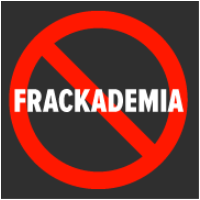“Frackademia” Fueling “Frackomania” as California Counts Its Billions Early

How does this sound? Instead of the country facing an energy crunch in the near future as oil and gas supplies run out, unproven renewable sources like solar fall flat and conservation efforts run afoul of human nature, we experience a new Gold Rush that results in 97% energy independence by 2035.
How about 2 million new jobs and $25 billion in California’s state coffers by 2020?
That’s the promise held out by supporters of hydraulic fracturing, or fracking, a controversial method of oil extraction that could unlock billions of barrels of oil otherwise not accessible. It’s especially true in California, where the state literally sits on a gigantic slab of oil-permeated rock called The Monterey Shale.
The federal government estimates that more than 60% of the nation’s shale oil is in Central California and could produce 15.4 billion barrels of oil.
While the state prepares to finally consider regulations governing fracking—which has been linked to groundwater contamination, air pollution, releases of methane gas, micro-earthquakes and sink holes but still lacks even the most basic disclosure rules about where it occurs, the chemicals being pumped into the ground and resulting environmental effects—the energy industry has been busy making its case for relatively unfettered use of the process.
But since most people are skeptical of pronouncements about energy extraction from the energy industry, it is forced to look for more legitimate and accepted sources of “independent” information.
Steve Horn at DeSmogBlog thinks they have found a good one. He noted the release of a new report by the University of Southern California, “The Monterey Shale & California’s Economic Future,” that blows past environmental assessments as being beyond its scope and zeroes in on the potential economic impacts for California as “clearly and objectively as possible.”
Horn wonders how objective that can be when the Western States Petroleum Association, a lobbying arm of the industry, gets the sole shoutout as a funding source, “with the mutual understanding that the research will be the product of independent efforts at the University of Southern California and The Communications Institute so as to remain objective and nonpartisan.”
The Communications Institute is a public relations outfit that does a lot of work for USC's Global Energy Network (GEN), a lead conductor of the study. Horn says GEN does not list its funding sources, but membership fees range between $25,000 and $500,000 per year and its board members include representatives from BP America, ExxonMobil, Chevron, Anadarko and General Electric.
One of the study’s co-authors, Fred Aminzadeh, worked for Unocal for 17 years and is founder and president of Fact-Corp, a global oil and gas industry consultancy firm, and has numerous other ties to the industry. He is also executive director of GEN.
The study was not peer-reviewed or published in an academic journal, but it can be read on the Communications Institute website. That doesn’t mean it wasn’t reviewed by other reliable sources. Two of the three people thanked by the report’s authors for offering their independent assessments are also tied to the industry. Henry David Lee is a past consultant to General Electric, Gulf Oil and Texaco, and Hillard Huntington is on the National Petroleum Council.
“Frackademia” hasn’t made the dictionary yet, but critics use it to describe the promotion—by corporations with an agenda—of seemingly legitimate, independent, academic and scientific inquiries into fracking. Examples seemingly abound.
Horn cites a report released six months ago by Los Angeles County extolling the virtues and safety of fracking, which was actually written by Cardno Entrix. The Houston-based company was a consultant to the U.S. Department of State on TransCanada’s Keystone XL Pipeline and wrote the official environmental reports for the 1,700-mile conduit from Canada to Texas. The company found that arguably the dirtiest source of energy on the planet would have “limited adverse environmental impact.”
The USC report acknowledges that there are critics who are focused on potential environmental problems from fracking, and “such problems, were they to materialize, . . . could overwhelm the proposed benefits.” But “the balance of benefits and costs has not yet been definitively established.”
It will be up to future “independent” studies to determine if fracking was worth the cost.
–Ken Broder
To Learn More:
“Frackademia” Strikes Again at USC with “Powering California” Study Release (by Steve Horn, DeSmogBlog)
The Monterey Shale & California’s Economic Future (University of Southern California) (pdf)
Keystone XL Contractor and SUNY Buffalo Shale Institute Conduct LA County's Fracking Study (by Steve Horn, DeSmogBlog)
“Discussion Draft” of First-Ever Fracking Regulations Raises a Howl from Environmentalists (by Ken Broder, AllGov California)
- Top Stories
- Controversies
- Where is the Money Going?
- California and the Nation
- Appointments and Resignations
- Unusual News
- Latest News
- California Forbids U.S. Immigration Agents from Pretending to be Police
- California Lawmakers Urged to Strip “Self-Dealing” Tax Board of Its Duties
- Big Oil’s Grip on California
- Santa Cruz Police See Homeland Security Betrayal in Use of Gang Roundup as Cover for Immigration Raid
- Oil Companies Face Deadline to Stop Polluting California Groundwater





